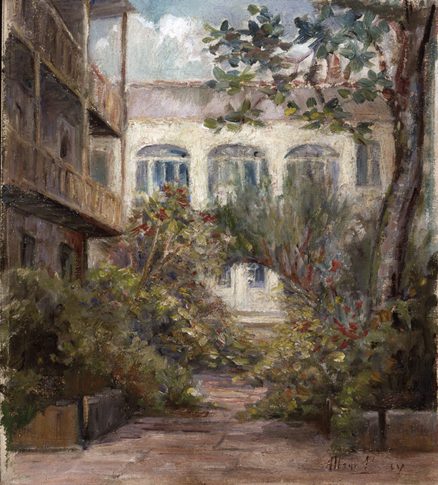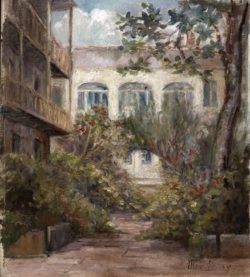Christian Woman’s Exchange
The Christian Woman's Exchange provided rooms for rent, consignment shops for income, and affordable lunches for women of every social class in New Orleans.

Courtesy of The Historic New Orleans Collection
Christian Woman's Exchange. Kinsey, Alberta (Artist)
The Christian Woman’s Exchange was the first New Orleans women’s organization established by women for women. Organized in April 1881 and chartered in May of the same year, the Christian Woman’s Exchange was structured much like the original woman’s exchange groups located in the northeastern United States. Their buildings housed consignment shops, rooms for rent, and dining rooms for women of every social class. As the needs of women changed, the group modified its mission to promote public history education in and out of the classroom. In 1998, the organization dropped the word Christian from its name so as to not appear exclusively Christian or religious in its work. Through their two historic house museums—the Hermann-Grima House and Gallier House—the Woman’s Exchange offers a glimpse into nineteenth-century Louisiana life from the perspective of both the wealthy and the enslaved.
The Early Years
The first woman’s exchange, in which women anonymously sold handmade items in a consignment shop to earn money, was established in 1832 in Philadelphia. The movement accelerated as many formerly wealthy women lost their husbands during the Civil War (1861–1865) or found themselves penniless after the economic depression of 1873. Though working outside the home was still frowned upon, these women desperately needed to provide for their families, and woman’s exchanges allowed them to do so while remaining anonymous. The Christian Woman’s Exchange (CWE) in New Orleans was the first woman’s exchange organized in the Deep South.
CWE’s founders adopted a general mission statement summarizing the organization’s purpose: to encourage and assist women in their efforts to provide for themselves and their families. Within two weeks, the CWE located a space on Bourbon Street to serve as their headquarters. The group received cheap rent and free telephone installation, and the gas company waived the deposit fee. Less than two months later, the CWE operated a consignment shop, a small boardinghouse, and an affordable lunchroom. In April 1882, the end of the group’s first full year of operation, the treasury report showed a profit of more than $100.
The Organization Grows
In the late nineteenth and early twentieth centuries, the CWE continued to raise funds for and provide charitable contributions to women from every social class. The group also published The Creole Cookery Book, participated in the 1884 World’s Cotton Centennial, sponsored a nursery for working mothers, and raised money to purchase a house for their new headquarters and boardinghouse. Located on the corner of South and Camp Streets, the house contained more than twenty rooms that the CWE could rent. After some legal opposition, the group acquired the space, rented rooms, and opened a free circulating library.
Between 1906 and 1915, the house on Camp Street suffered major damage from everyday use and repeated hurricanes. The CWE needed to install fire escapes, repair the galleries, replace windows, restore the roof, and address structural problems. In 1922, the group rented the Camp Street house to the Daily States, a local newspaper, and searched for quarters elsewhere. After auctioning its furniture and donating its linens, the CWE moved temporarily to a space in the lower Pontalba Building in the city’s French Quarter. Six months later, the group moved again, this time to a space on Royal Street. Finally, in 1924, the CWE purchased the Hermann-Grima House from the Society for the Prevention of Cruelty to Animals for $17,500.
The Hermann-Grima House, named for its owners Sam Hermann and, later, Felix Grima, was a mansion built in 1831. The property consisted of a three-story house, a stable and carriage house, several outbuildings, and a courtyard. When the Daily States purchased the Camp Street house in 1927, the CWE paid off the mortgage for its new headquarters while still operating the shop on Royal Street. Despite the Great Depression, the CWE’s financial status remained stable throughout the early twentieth century.
In the 1960s, the CWE’s mission expanded to include historic preservation. In 1967, restoration of the house and grounds commenced and, in 1971 the Hermann-Grima House was recognized as a National Historic Landmark. Subsequently, it was opened to the general public and continues to operate as a historic house museum. In the 1990s, the CWE purchased the historic Gallier House on Royal Street. Currently, the Woman’s Exchange continues to operate these two house museums and educate the public about nineteenth century New Orleans life.
